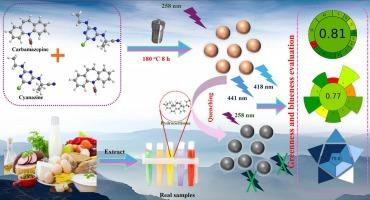基于碳量子点的比例荧光传感器检测食品样品中的氢化可的松
IF 9.8
1区 农林科学
Q1 CHEMISTRY, APPLIED
引用次数: 0
摘要
双发射荧光传感器具有良好的自校准能力,可用于精确检测目标分析物。本文采用水热策略,以氰嗪和卡马西平为材料,构建双发射碳量子点(D-CQDs)。有趣的是,D-CQDs在418和441 nm处显示两个荧光发射峰。同时,还观察到荧光强、水溶性好、光稳定性好等优良特性。所建立的D-CQDs可用于氢化可的松(HYD)的灵敏和选择性检测。在最佳传感条件下,建立了ln(F0/F)与HYD量之间的工作曲线。线性范围为0 ~ 140 μM,检出限为0.029 μM。感应机理为静态淬火效应(SQE)。该方法可用于食品样品中HYD的测定,回收率为93.37 ~ 103.87 %。绿色评价表明,该平台具有良好的生态友好性和可持续性。本文章由计算机程序翻译,如有差异,请以英文原文为准。

Ratiometric fluorescence sensor based on carbon quantum dots for hydrocortisone detection in food samples
Due to the prime self-calibration capability, dual emission fluorescence sensor can be utilized to accurately detect target analytes. Herein, the hydrothermal strategy was employed to construct dual emission carbon quantum dots (D-CQDs) via cyanazine and carbamazepine as materials. Interestingly, D-CQDs displayed two fluorescence emission peaks at 418 and 441 nm. Meanwhile, some excellent features could be observed, such as strong fluorescence, good water-solubility, and photo-stability. The as-developed D-CQDs could be successfully applied to detect sensitively and selectively hydrocortisone (HYD). Under the optimal sensing conditions, a working curve was developed between ln(F0/F) and HYD amounts. The linear range was 0–140 μM with detection limit of 0.029 μM. The sensing mechanism was assigned to static quenching effect (SQE). Moreover, this promising platform was used successfully to determine HYD in food samples with satisfied recoveries of 93.37–103.87 %. The greenness assessments indicated that this platform possessed excellent ecological friendliness and sustainability.
求助全文
通过发布文献求助,成功后即可免费获取论文全文。
去求助
来源期刊

Food Chemistry
工程技术-食品科技
CiteScore
16.30
自引率
10.20%
发文量
3130
审稿时长
122 days
期刊介绍:
Food Chemistry publishes original research papers dealing with the advancement of the chemistry and biochemistry of foods or the analytical methods/ approach used. All papers should focus on the novelty of the research carried out.
 求助内容:
求助内容: 应助结果提醒方式:
应助结果提醒方式:


